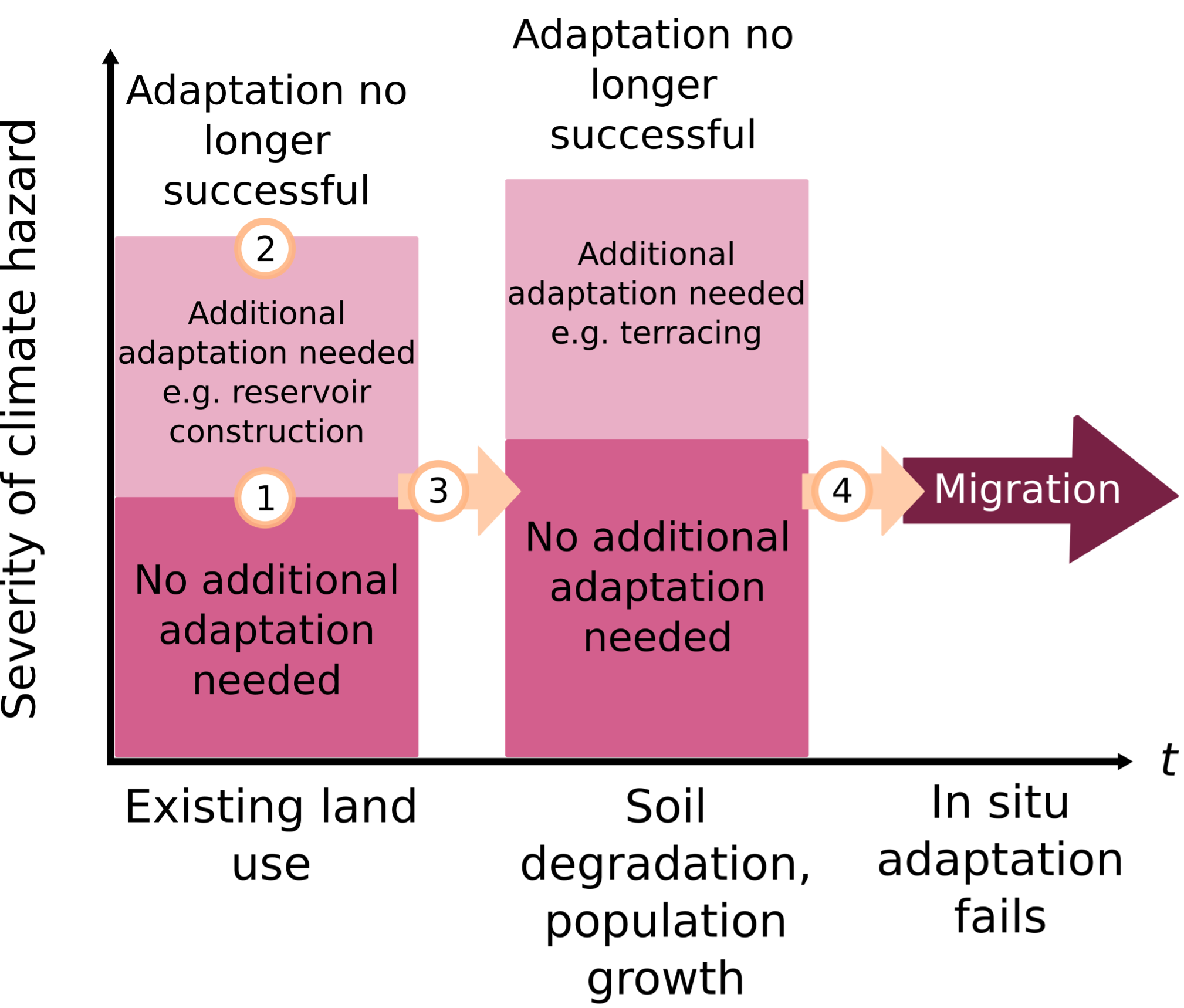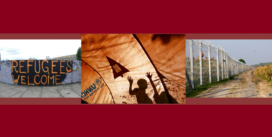Migration as Climate Adaptation
by Benjamin Keenan, PhD Candidate, McGill University
Anthropogenic climate change is now viewed as an existential threat that requires society to question how we live and how we can use our resources more sustainably. The increase in atmospheric CO2, from about 280 ppm prior to the Industrial Revolution (ca. 1850) to approximately 411 ppm today has led to an increase in the number and severity of extreme weather events – including extensive and frequent forest fires, as well as coastal flooding caused by rising sea levels.[i] These events are causing the displacement of people, and will continue to do so, but this is not a new phenomenon.
Dry periods in prehistory have been correlated with times of social upheaval, which, in some cases, led to large-scale restructuring of society including migrations of people. These chaotic periods are sometimes referred to as “collapses.” The Akkadians in Mesopotamia,[ii] the Khmer in Cambodia,[iii] and the lowland Maya of Mesoamerica were all affected by climate variability.[iv] The lowland Maya were affected by multiple environmental stresses such as droughts, floods and soil erosion, as well as socio-political stresses including growing populations, disease, and internecine warfare, at different times in their history, and ultimately experienced a profound transformation, sometimes referred to as a collapse, following a period of extensive drought around 800-900/1100 CE. The Maya experienced earlier droughts, including during the Terminal Preclassic, which also coincided with an earlier period of upheaval and transformation, resulting in mass migration.[v] When systems were pushed to their limits or failed, the Maya re-adapted and developed better approaches (see Fig. 1).
Water management strategies were especially important in the southern Maya lowlands where the water table was too deep to be accessed by digging wells. However, aguadas, which are natural water-filled depressions, are common in the area. Thus, reservoirs were constructed at some sites to collect runoff water during the wet season and canals were dug to direct runoff water into storage areas. As cities grew, particularly in the Late Classic period, these systems evolved and were expanded in size and complexity. Early failures, such as the siltation of reservoirs, helped inform later strategies, which were better equipped to adapt to the increasing population and greater water scarcity.[vi] The response of the ancient Maya to drought has been described as “on-going management of disasters”; a society on a knife’s edge and only one disaster away from demise (“ecological disaster management”).[vii]
Despite the adaptive efforts described above, between 800-900/1100 CE, monumental construction at many large Maya ceremonial centres ceased and many cities were abandoned. Quantitative estimates of rainfall reduction suggest that annual precipitation decreased between 41 and 54% and up to 70% during drought periods.[viii] This suggests that water management strategies, which were constantly being modified and pushed to their limit, could no longer sustain the population. The precarious nature of management strategies supports the ecological disaster management model. When this happened, cities were depopulated and people were forced to migrate. The mechanisms of transformation are not well understood, but may have related to increased competition between neighbouring city-states that were vying for precious resources.
The Maya lowlands was not one unified political entity, but a number of polities – and that warfare as a result of competition for dwindling resources was a possible and likely scenario. An earlier drought during the Terminal Preclassic in the northern lowlands coincided with evidence for defensive earthworks between the north and south, perhaps in order to slow “aggressive” migrants from the dry north to the wetter south.[ix] It is interesting that the northern lowland Maya migrants escaping drought were aggressively prevented from migrating southwards during the Terminal Preclassic drought but received migrants seemingly welcomingly during the Terminal Classic droughts that occurred later. Although many cultural adctivities in the southern lowlands did cease abruptly and there was widespread depopulation, it is interesting to note here that there is disagreement in referring to this as a collapse, because indigenous Maya people survive today. It has instead been referred to as a period of restructuring or societal transformation.
Figure 1. Adaptation and thresholds in the lowland Maya system, after Adger et al. (2009) in McLeman (2018).[x] Time on the x-axis encompasses the initial growth of society followed by population growth and associated deforestation and population growth. 1. An initial climate event (e.g. a drought event) leads to an adaptation such as the necessity of constructing a reservoir to store water. 2. The initial adaptation response is no longer sufficient (the reservoir cannot meet the demand for water in prolonged drought conditions). 3. In the context of climate change as well as tackling environmental degradation to meet the needs of a growing population, other forms of land use are pursued. This might involve the use of novel sources of fertiliser (such as human waste), and terracing. 4. Finally, all forms of “in situ” adaptation fail, necessitating a final adaptive response- migration.
Like the lowland Maya, who were able to migrate as a way of adapting to drought, we must consider migration as a realistic means of climate adaptation. Modern day climate change has been described as an existential problem. This means that we cannot just consider technological solutions, but ones that question our existence on Earth. Andrew Baldwin describes the challenge as an opportunity for “…imagining new worlds and new possibilities for collective life”.[xi] This will necessitate the reconsideration of society’s core values, including the notion of citizenship, to facilitate movement of people from hazardous to safer areas.[xii] The case of low-lying tropical Pacific islands is a good example of the need to find a solution for the re-location of their inhabitants immediately. In fact, some households in Fiji have already begun to relocate in order to avoid rising sea levels and flooding.[xiii] Also, climatic conditions are described as having played a significant role for asylum seeking between 2011 and 2015.[xiv] James Aimers notes that mass migrations are not supported by archaeological data but suggests that smaller migrations were certain[xv] and Andrew Baldwin makes a similar observation about modern mass migrations in response to climate change.[xvi] Using the insights from accounts of societies that have already been affected by and responded to climate change we can start to pre-empt and facilitate the inevitable movement of climate migrants and refugees.
[i] Pieter Tans and Ralph Keeling, “Trends in Atmospheric Carbon Dioxide,” Global Monitoring Laboratory, accessed March 30, 2020, www.esrl.noaa.gov/gmd/ccgg/trends/.
[ii]. H. Weiss et al., “The Genesis and Collapse of Third Millennium North Mesopotamian Civilization,” Science 261, no. 5124 (1993): 995–1004, https://doi.org/10.1126/science.261.5124.995.
[iii]. Brendan M. Buckley et al., “Climate as a Contributing Factor in the Demise of Angkor, Cambodia,” Proceedings of the National Academy of Sciences of the United States of America 107, no. 15 (April 2010): 6748–6752, https://doi.org/10.1073/pnas.0910827107.
[iv]. David A. Hodell, Jason H. Curtis, and Mark Brenner, “Possible Role of Climate in the Collapse of Classic Maya Civilization,” Nature 375, no. 6530 (June 1995): 391–394, https://doi.org/10.1038/375391a0.
[v] James J. Aimers, “What Maya Collapse? Terminal Classic Variation in the Maya Lowlands,” Journal of Archaeological Research 15, no. 4 (September 2007): 329–377, https://doi.org/10.1007/s10814-007-9015-x.; Hodell, Curtis, and Brenner, “Possible Role of Climate ,” 391–394.
[vi]. Lucero, Gunn, and Scarborough, “Climate Change,” 479–494.
[vii]. Peter M.J. Douglas et al., “Impacts of Climate Change on the Collapse of Lowland Maya Civilization,” Annual Review of Earth and Planetary Sciences 44, no. 1 (June 2016): 613–645, https://doi.org/10.1146/annurev-earth-060115-012512.
[viii]. Evans et al., “Quantification of Drought,” 498–501.
[ix] Bruce H. Dahlin, “Climate and Prehistory on the Yucatan Peninsula.” Climatic Change 5 (3) (1983): 245–63. https://doi.org/10.1007/BF02423521.
[x] W. N. Adger, I., Lorenzoni, and & K. L. O’Brien, Adapting to climate change: thresholds, values, governance (Cambridge, Cambridge University Press, 2009): 1–22; Robert McLeman, “Thresholds in Climate Migration.” Population and Environment 39, no. 4 (2018): 319–38, https://doi.org/10.1007/s11111-017-0290-2.
[xi] Andrew Baldwin, “Pluralising Climate Change and Migration: An Argument in Favour of Open Futures.” Geography Compass 8 (8) (2014): 516–28. https://doi.org/10.1111/gec3.12145.
[xii]. Ben Orlove, “Human Adaptation to Climate Change: A Review of Three Historical Cases and Some General Perspectives,” Environmental Science and Policy 8, no. 6 (December 2005): 589–600, https://doi.org/10.1016/j.envsci.2005.06.009.
[xiii] Karen E. McNamara and Helene Jacot Des Combes, “Planning for Community Relocations Due to Climate Change in Fiji.” International Journal of Disaster Risk Science 6 (3) (2015): 315–19. https://doi.org/10.1007/s13753-015-0065-2.
[xiv] Guy J. Abel, Michael Brottrager, Jesus Crespo Cuaresma, and Raya Muttarak, “Climate, Conflict and Forced Migration.” Global Environmental Change 54 (2019): 239–49. https://doi.org/10.1016/j.gloenvcha.2018.12.003.
[xv] Aimers, “What Maya Collapse?” 329–377
[xvi] Baldwin, “Pluralising Climate Change and Migration.” 516–28.

